Touch Me Not Plant: Uses, Side Effects, Research
Lajjalu Mimosa pudica Linn. is a small plant which is used mainly in the treatment of wounds, piles, uterine prolapse, and diarrhea.
Botanical name- Mimosa pudica Linn.
Family- Leguminosae
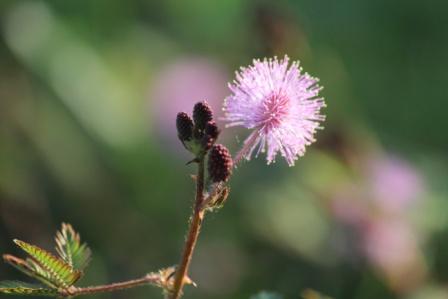
Table of Contents
Vernacular names
Names in different languages:
English name – Sensitive plant
Hindi name – lajalu, chui mui
Bengali name – Lajjavati
Kannada name – Nachike mullu, Nachike Gida
Gujarati name – Reesamani
Tamil name – Tottalavadi
Sanskrit synonyms
Lajjalu – Sensitive plant and leaves close on touch
Samanga – The plant is symmetrical
Sankochani, Namaskari – The leaves fold like folding of hand on touch.
Khadira patrika – Resembles the leaf of Khadira (Acacia cathechu) plant.
Raktapada, Raktamoola, Tamramoola – Coppery red colored root
Gandhakari – Has an aroma
Khadirikaruna,
Prarochani – improves taste, relieves anorexia.
Shamipatra – leaves resemble those of Shami plants.
Jalakarika
Namaskari – Leaves will be folded on touch giving an impression that the plant is saluting
Prasarini – grows and spreads quickly
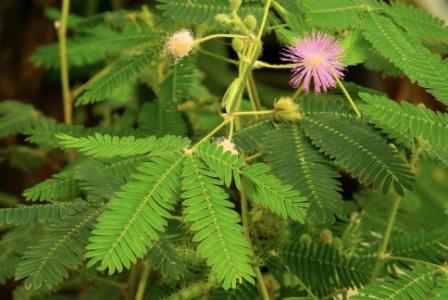
Classical categorization
Charaka Samhita –
Sandhaniya – Group of herbs useful in quick wound / fracture healing
Purisha sangrahaneeya – Group of herbs that increase the bulk of feces
Sushruta- Priyangvadi gana, Ambashtadi gana
Vagbhata- Priyangvadi gana
Bhavaprakasha- Guduchyadi varga
Kaiyyadeva Nighantu- Oushadi varga
Raja Nighantu- Parpatadi varga
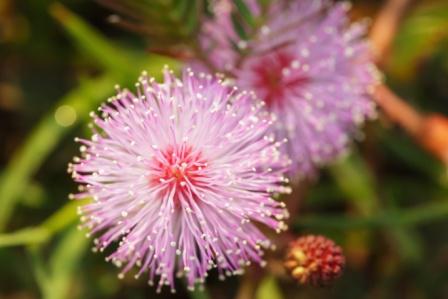
Varieties
There are about 4000 species of mimosa. Mimosa pudica is a small herb which grows like a weed in a short period of time. It is a native of Brazil but now found all over India in the temperate climate. The leaves are arranged symmetrically and close in touch; hence the name sensitive plant. The flowers are pink in color.
1. Lajjalu – Mimosa pudica
2. Viparita lajjalu Biophytum sensitivum
Properties, part used, dosage
Touch me not plant – medicinal properties
Rasa (taste) – Kashaya – Astringent, Tikta – Bitter
Guna (qualities) – Laghu – Light to digest, Rooksha – Dryness
Vipaka- Katu – Undergoes pungent taste conversion after digestion
Veerya – Sheeta – Coolant
Karma- Kapha-pitta hara (reduces the vitiated Kapha and Pitta Dosha)
Pharmacological actions- Antiviral, Spasmogenic, Diuretic, Hyperglycemic, Anti fertility, Wound healing
Therapeutic indications – Yoniroga, Atisara, Raktapitta, Sopha, Vrana, Bhagandara
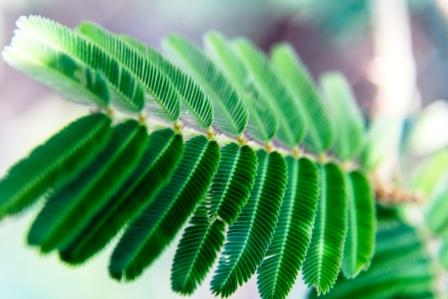
Part used– Root, whole plant.
Paste of the plant is used (as poultice) for external use.
Dosage-
Fresh juice 10-20 ml
Decoction: 50 – 100 ml, in divided doses, per day.
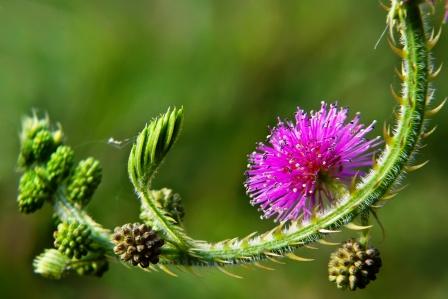
Chemical composition
The plant contains mimosine and turgorin. The periodic leaf movements exhibited by the plant are due to the presence of derivatives of 4-O- gallic acid. The aerial part of the plant Mimosa pudica contains C- glycosylflavones, 2-Orhamnosylorientin. The root of the plant contains 10% tannin and 55% ash. The seed contains mucilage
Morphology
Diffuse undershrub
Stems – Prickly
Leaves – Compound, Sensitive, sessile, linear – oblong
Flowers – Pink in color, Golbose head,
Fruits – pods, slightly recurved
Sanskrit verse, indications
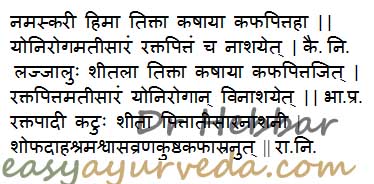
Traditional indications:
Yoniroga – useful in female reproductive system related disorders such as heavy periods
Atisara – diarrhea, dysentery
Raktapitta –Bleeding disorders such as nasal bleeding, heavy periods, etc
Pittatisara – diarrhea due to excess Pitta, ulcerative colitis
Shopha – inflammation
Daha – burning sensation, as in gastritis, neuropathy, burning sensation in eyes etc
Shrama – tiredness, fatigue
Shwasa – asthma and chronic respiratory disorders
Vrana – Ulcers, wounds
Kushta – skin diseases
Asra – blood disorders such as abscess, skin disorders, bleeding disorders such as menorrhagia, nasal bleeding etc.
How to use the “Touch me not” plant for wound healing?
Uses of Lajjalu:
- The decoction of the root in a dose of 45-50 ml is taken to get relief from renal stones, urinary complaints and asthma.
- The decoction of the plant Mimosa pudica is consumed in a divided dosage of 10-15 ml thrice a day to get relief from diarrhea, bleeding piles, diabetes.
- The paste of the plant is applied over fresh wounds to stop bleeding, to treat skin diseases.
- The paste of the plant is applied as poultice, over the affected area, to relieve vaginal prolapse, anal prolapse.
- The powder of the seed is given in a dose of 4-6 g in lower sperm count.
- The paste of the leaves of the Mimosa pudica plant is applied to treat fractures of the bone.
- Fresh juice of decoction of Lajjalu (Mimosa pudica) is administered in the dose of 15-20ml twice daily in menorrhagia.
Ayurvedic formulations
Important formulations containing Lajjalu:
Kutaja avaleha: It is a type of semisolid preparation used in the treatment of piles, ulcerative colitis, diarrhea, IBS, anemia, bleeding disorders, gastritis, inflammatory conditions.
Ural BPH capsule: It is a capsule used for the treatment of Benign Prostatic Hyperplasia.
Selip syrup and tablet: This formulation is used in the treatment of piles, constipation, and anal fistula
Samangadi churna: Samangadi Churna is an Ayurvedic medicine, in herbal powder form. It is used in the treatment of bleeding hemorrhoids.
Palsinuron capsule: This capsule is used in the treatment of cervical spondylitis, brachial neuralgia, paralysis.
Lakshadi churna: Lakshadi Churnam is an Ayurvedic powder medicine used in the treatment of nasal bleeding, heavy periods and other bleeding disorders. It is best avoided in delayed periods, less menstrual bleeding (oligomenorrhea).
Pilocure tablet: It is a tablet used for the treatment of bleeding piles and hemorrhoids.
Research, Side effects
Research articles related to Mimosa pudica:
- Anti microbial activity: The antimicrobial activity of Lawsonia inermis, Mimosa pudica, Cestrum diurnum and Solanum xanthocarpum was determined by agar disc diffusion method against five strains of microbes: Bacillus pumilus, Micrococcus luteus, Escherichia coli, Pseudomonas aeroginosa and Candida albicans. All the selected plants exhibited antimicrobial activity but the degree of their potency varied. The results showed that Cestrum diurnum and Mimosa pudica showed more antimicrobial activity as compared to Lawsonia inermis and Solanum xanthocarpum.
- Broad spectrum anti microbial activity: Antimicrobial activities of 50% methanolic crude extracts of Mimosa pudica L were evaluated against different bacterial strains (E.coli MTCC-443, Pseudomonas aeruginosa MTCC-4673, Staphylococcus aureus MTCC- 3160, Bacillus subtilis MTCC-441, Streptococcus pyogenes MTCC-1926.) by agar well diffusion method & MIC determination. The crude extract showed a broad spectrum of antibacterial activities by inhibiting the respective bacteria in Agar well diffusion assay.
- Adaptogenic and nootropic activity: Ethanolic extract of pudica at the dose of 500 mg/kg produces potential changes in chronic Alzheimer’s model and stress.
- Ethno medical and traditional use of Mimosa pudica: Recent studies have found that the extracts of this plant can be used for controlling child birth. Traditional herbal doctors recommended this plant for the treatment of bronchitis, general debility and impotence.
Mimosa pudica side effects:
It is best to avoid during constipation and scanty periods.
Interaction with medicines, supplements
Can this be used while taking Homeopathic medicine?
Yes. This product does not react with homeopathic medicine.
Can this medicine be continued while taking supplements like multivitamin tablets, Omega 3 fatty acids etc?
Yes. Generally, this product goes well with most dietary supplements. However, if you are taking more than one product per day, please consult your doctor for an opinion.
With western
medicines
Seek your
doctor’s advice if you are taking this product along with other western
(allopathic / modern) medicines. Some Ayurvedic herbs can interact with modern
medicine.
If both Ayurvedic and allopathic medicines are advised together, then it is
best to take Allopathic medicine first, wait for 30 minutes and then take the
Ayurvedic medicine.
Author:
Dr.B.K.Prashanth M.D (Ayu), Ph.D | E mail: drprashanthbk@gmail.com
Sthanika Karma (Systemic Action)
External application
Promote faster fracture and wound healing, Styptic in action. Indicated in Fistula.
Internal administration-
Digestive System – Absorbent, Indicated in Diarrhea, dysentery, Bleeding piles etc.
Circulatory system – Constrict smaller blood vessels and helps to prevent bleeding, Acts as a blood purifier and is indicated in edema, chest injury, epistaxis etc.
Reproductive system – Seed has Aphrodisiac action. indicated in menorrhagia
Excretory system – Indicated in diabetes, sikatameha etc.
Satmikarana – Indicated in animal poisoning, facture, wounds etc.
Tapakrama – indicated in fever, burning sensation









41 comments on “Touch Me Not Plant: Uses, Side Effects, Research”
Sophie
Hello Dr.Hebbar! Thanks for all your teachings. I am learning a lot. Can you talk about what you mean by controlling childbirth?
Dr J V Hebbar MD(Ayu)
Hi, it means, it is a potential contraceptive herb. 🙂
Sophie
Ah, the hint is in the name ‘touch me not’ 🙂 Historically, have women used it to try and prevent pregnancy (I wouldn’t want to rely on this alone of course), or is it just something you want to avoid if you want to get pregnant?
Dr J V Hebbar MD(Ayu)
It is not contra-indicated in pre- pregnancy time, as it is indicated in Raktapitta and Yoniroga – menorrhagia.
But excess consumption of its Kashaya or usage during pregnancy is best avoided.
Sophie
Thank you, Dr. Hebbar.
Raji
Read that this plant is very good for incontinence. Is it correct and in what form should a person take the medicine
selva
Did touch me not is used to lose weight?
Dr J V Hebbar MD(Ayu)
As per a research report – the root is useful in obesity.
Reference: . Balamurugan R. Smilax chinensis Linn. (Liliaceae) root attenuates insulin resistance and ameliorate obesity in high diet induced obese rat. South Indian Journal of Biological Sciences. 2015; 1(1):47–51.
ramesh ramesh2276
Is it poisonous by using raw and 200no quantity at a time
Dr J V Hebbar MD(Ayu)
Such a high dose is not recommended. It is not poisonous.
Alan Her
Would you recommend mimosa pudica for a first degree prolapsed uterus? If so, how much should be taken and for how long?
Dr J V Hebbar MD(Ayu)
I could not find a research article but M pudica is used in the Ayurvedic treatment of IC.
Sushmita
What about taking this solution when having piles occurred due to pregnancy, constipation?
Dr J V Hebbar MD(Ayu)
Can be taken after consulting an ayurveda doctor
chinmay kumar dash
Thank you for your information about lajwati seeds
Ako Sylvester
Hi Doctor, can you tell me how to use the stems in particular externally and internally?
Dr J V Hebbar MD(Ayu)
It is used both externally and internally.
Eugene
Please, can anyone tell me whether mimosa pudica, being a broad spectrum antimictobial, is safe fpr the beneficial bacteria in the gut?
Susana
Hello Doctor,
are you still using mimosa pudica as a treating method? do you think that the alkaloid mimosine toxic in all forms or only in high dosages?
Ravi
Hi can we use this for diabetics? How long it’s take to cure ???
Dr J V Hebbar MD(Ayu)
It does not cure diabetes completely.
Dr.Himabindu
Can this lajjalu containing anti hemorrhoidal tablets and capsules are safe to take in pregnancy induced bleeding hemmoroids??
Manju
Hi doctor ,can this herb be used as a medicine for pcod?
Dr J V Hebbar MD(Ayu)
Its root decoction – in a dose of 15 ml, 2 times a day before food for 2 months can be useful.
Decoction – 1 tablespoon of herb + 1 cup of water, boil and reduce to half a cup. Filter. Consume when hot.
carmn
Thank you very much. Please help me find a good Ayurveda doctor
Dr J V Hebbar MD(Ayu)
Your place?
Dr J V Hebbar MD(Ayu)
The decoction is consumed in a dose a divided dosage of 10-15 ml thrice a day get relief from diarrhea, bleeding piles, diabetes.
Decoction is prepared by adding one big spoon of leaves to one cup of water, boil and reduce to half a cup. Filter.
Nithya
Hi doctor
Can this be used for making the mensuration cycle regular.
lucy Kern
Can you please tell me what part of this plant kills parasites. Is it the seeds or the powder made from the seeds and how do you take it to insure the best results?
Dr J V Hebbar MD(Ayu)
Hi, whole plant is used.
Bianca
How do i make a paste for uterine prolapse? How do I use it for the prolapse?
Dr J V Hebbar MD(Ayu)
It is made into paste with water and a little bit jatyadi taila oil. It is applied locally.
Adam
Greetings,
How much should I take to help heal my intestinal tract from bloating/diarrhea/slight constipation? The whole plant is used for this specific problem, correct?
Autumn
Hello. Is it safe to take a preparation of the seeds? It has been recommended to me for parasite treatment.
Abhishek Kadam
Where will i get this fully grown plant in large quantity, its really hard to find it in pune?
Dr J V Hebbar MD(Ayu)
Please contact local herb suppliers and shops.
Rita D. McCartt-Kordon
Can this plant be used for bacterial infection? Paste? How much to apply to wound? Cat bite! Thank you! Also, I love near Knoxville, TN. USA. Can you help me find an achieved doctor, or any doctor besides regular trained doctor?!! Thank you so much!
Ramyashree g
I want to know whether the fresh juice of the leaves can be consumed for pcos ? ….I saw a video suggesting this plant for pcos …. saying to consume fresh juice continuously for 9days in the morning…..can anyone please tell me as I am confused as it is mentioned to avoid during scanty periods …help me out
Dr J V Hebbar MD(Ayu)
It is indeed useful in treating PCOS. Yes, it can cause scanty periods, but it will help in reducing the ovarian cyst. There is an in vivo study on this in PCOS. There is also another animal experimental study to prove that it helps to normalize estrous cycle.
The scanty periods can be well addressed by other medicines such as Raja Pravartini Vati.
BhabaniSankarBehera
Can I use it for varicocele
My doctor prescribed it to me
Dr J V Hebbar MD(Ayu)
Yes.